| |
|
|
Newsletter Intro
Greetings from Dr. Lent. |
Facial Aging/Facelift
Information to help you make your plastic surgery decisions. |
Dr. Lent in Uganda - Part II
Dr. Lent recounts his travels to Africa and the amazing people he met there. |
|
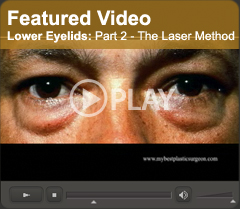 |
|
|
| |
Newsletter Introduction |
|
| |
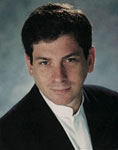 |
Dear Friends,
This past year has seen many changes for all of us and several new innovations in plastic surgery. In this, our second newsletter, I tell some of the more personal side to my recent participation in Operation Heal Africa's medical mission to Uganda. I also discuss a new facelift technique that I am especially excited about. I hope you enjoy these articles, and, as always, I welcome your feedback.
I just want to wish everyone a happy holiday season and especially a healthy and prosperous new year!
Sincerely,
Warren Lent, MD |
|
|
|
|
| |
Dr. Lent in Uganda - Part II
Near the beginning of my week volunteering with Operation Heal Africa in Bombo, Uganda, my daughter came rushing over with an elderly gentleman in tow. "Dad, I think there is someone here that you need to take a look at" and proceeded to introduce me to a kind, elegantly dressed, soft-spoken, man named Christopher, whose appearance stood in stark contrast to the dirty, smoky and poor conditions that surrounded us. He politely approached me, and while removing his hat, he asked if I could help him with what turned out to be a baseball-sized tumor growing out of his forehead. He, accompanied by his caring son, waited patiently throughout that week as we strove to break through the bureaucratic nightmare that envelops the Ugandan medical system. His plight embodied everything that we encountered and overcame while serving the people of Uganda.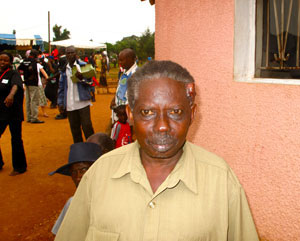
Our first challenge involved trying to get Christopher an x-ray of his skull to assess whether the tumor was invading the bone. This involved a little horse-trading with the nearby government hospital. In exchange for the x-ray I had to arrange for the radiologist to see our mission's eye specialist and receive a new pair of glasses. Before the x-ray could be read, it had to hang on a rack, outdoors, in the sun, to help develop the film. I also tried to get Christopher a pre-operative EKG, per American norm for a person of his age, but this major hospital had no such equipment.
Our next battle came when we tried to arrange for an appropriate operating room to remove his tumor and reconstruct his forehead. The government hospital had promised us use of their operating room, but we quickly were informed that all of the necessary equipment was broken, and that the operating room had been unusable for months. The single room concrete structure that we were able to commandeer at a nearby clinic was only useful for procedures that could be done with injectable local anesthesia only. Clearly, this was not a situation for an operation of this magnitude. What a predicament for a Beverly Hills, plastic surgeon. Finally, after a week of cajoling, pleading, begging and outright bribery, we were able to get the use of an operating room at a church-run private hospital about 25 miles away. Ultimately, we were able to secure these arrangements because of a very compassionate Ugandan surgeon named Dr. Peter, who was volunteering with us on Operation Heal Africa. Christopher finally had his tumor removed and his forehead reconstructed.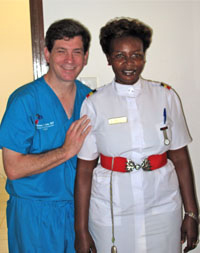 Diagnostic pathology services are sparse in Uganda and I have been unable to find out what this tumor was. My guess is that it was a Squamous cell cancer of the skin. Diagnostic pathology services are sparse in Uganda and I have been unable to find out what this tumor was. My guess is that it was a Squamous cell cancer of the skin.
There were three healthcare professionals I encountered during this mission who made especially strong impressions on me. One was Dr. Peter, a man who maintains an unusually calm and collected demeanor in the face of chronic bureaucratic obstacles and obscene shortages of medical resources. Without his knowledge and guidance, we surely would have been lost.
Next, was Nurse Grace, a statuesque woman, trained in Britain, who wore her nurse’s uniform with military precision and pride. She gave off an undeniable air of authority, confidence and strength. She used every bit of her power to get us whatever resources she could muster at the government hospital and seemed personally wounded when colleagues did not come through.
Perhaps the most significant member of our team was Dr. Fola May. Dr. May is a third year Internal Medicine resident at Harvard’s Massachusetts General hospital, who used her vacation time to put in long hours volunteering in Bombo. I was amazed that someone would take their valuable down time from an intense hospital work schedule and use it to work equally hard, for people she had never met, half a world away. Of our group, her skills were the most needed, as the majority of the patients required general medical care. She not only treated hundreds of patients, but also guided the rest of us to fill in where we could. She was absolutely essential to the success of this mission.
There were many frustrations and fortunately, even more triumphs in our short medical mission to Uganda. There are dozens of success stories and many wonderful people who gave of themselves to make it all happen. Hopefully, I’ve given you a little taste of what life is like in a country where medical resources are scarce, but, because of organizations like Operation Heal Africa, hope springs eternal. |
|
|
|
| |
Facial Aging/Facelift
Over the past two years I have been working on a new, innovative facelift method that I am really excited about. It has proven to be an incredibly powerful technique that doesn’t just remove excess skin, but tightens and correctly repositions the tissues and muscles of the neck and face. It restores the angles of the face and neck in a way that is very natural and pleasing. In short it correctly puts everything back to where they were when you were younger. For now, I’m calling this facelift the “Beverly Hills Power Lift”. 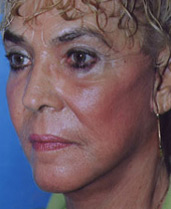 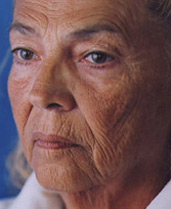
Before we get into this technique, let me take a moment to describe the various problems that lead to facial aging, and some of the various methods that have been used to correct them.
Facial aging is a slow but steady process that begins the moment we are born. Sun exposure and cigarette smoking can accelerate the process. The soft tissues of the face gradually stretch and migrate downward with the pull of gravity. This leads to three basic problem areas. First is flattening of the upper cheeks as the natural fat pad moves down-and-in, which also causes the line that extends down from the nose to the mouth, called the Nasolabial-fold, to deepen. The second problem area is along the jaw line, where loose skin, fat and muscle begin to hang, creating those dreaded jowls. The third, and perhaps the most important problem area is the neck. Not only can fat build up here, but bands can form above the Adams Apple due to hanging loose skin and muscle. These three problem areas are what my patients here in Los Angeles and Beverly Hills, complain about the most.
Many people are confused as to what exactly constitutes a facelift. A true facelift. focuses on the area from the upper cheeks down to the mid-neck. Other parts of the face that are often treated at the same time are the eyelids, with a Los Angeles Blepharoplasty, and the forehead, with a brow lift. For the purposes of our discussion, we'll consider those areas separately.
The old fashion facelifts all focused just on the stretched out, hanging skin. These techniques concentrated on removing this excess skin. They required incisions in front of the ear that extended up into the scalp, and incisions placed behind the ear that extended backwards into the hair. This can damage hair follicles and cause balding.
Plastic surgeons then began to focus on some of the deeper tissues, as we recognized that the aging process affected all of the components of the face. An important tissue layer in the cheek was discovered, called the SMAS. This is a thin layer of fascia that attaches to the important neck muscle called the Platysma. It is the Platysma that loosens, falls forward and forms those telltale bands. By adjusting the SMAS, the surgeon can tighten the neck muscles and restore a beautiful, youthful angle to the neck.
The Beverly Hills Power Lift takes this whole concept to the next level. It allows me to shrink and concentrate the cheek and neck tissue back to the volume of their youth. Simultaneously, it allows me to lift the neck muscles, jowls and cheeks back into the position they occupied earlier in life. An added benefit is that I can keep the total incision length to about half of the standard facelift and avoid going into the hair. In total, this new technique represents a powerful advance in facelift methods, by reducing stretched out tissue, repositioning everything back to their original location and minimizing the total incision length.
For questions regarding liposuction, plastic surgery or skin care, contact Dr. Warren Lent, MD, FACS, at 310.652.6500, via email at drlent@mybestplasticsurgeon.com or visit www.mybestplasticsurgeon.com.
|
|
|
|
